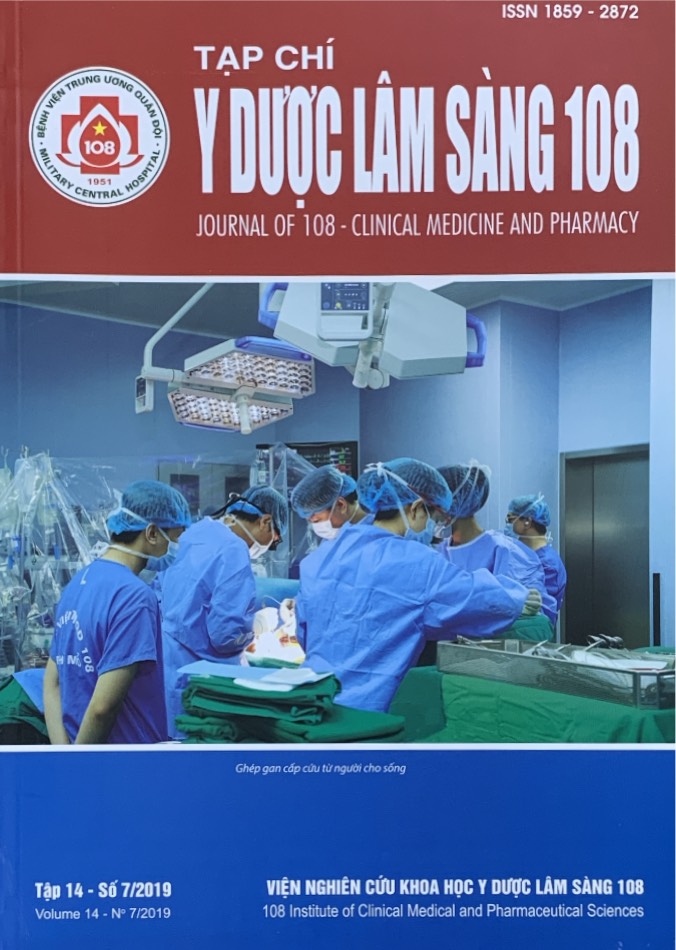Establishing a molecular biology procedure for detecting Helicobacter pylori resistance to clarithromycin
Main Article Content
Keywords
Abstract
Objective: To establish a quick and simple molecular approach for the screening of H. pylori and H. pylori carrying A2142G, A2143G mutations. Subject and method: Fifteen HP colonied endoscopsic biopsies were collected as studying subject. Modified polymerase chain reaction (PCR) was applied with intergration of amplification refractory mutation system (ARMS) technology. Result was confirmed by direct sequencing. Result: PCR-ARMS was successful established. The result showed that it’s sensitivity and specificity was similar to direct sequencing, but low price, less required equipment, technician and time-comsuming. Conclusion: A bi-directional allele specific PCR implemented with amplification refractory mutation system (ARMS) have been launched, which gave absolute concordance to the classical Sanger sequencing analysis.
Article Details
References
2. Nakamura A, Furuta T, Shirai N, Sugimoto M, Kajimura M, Soya Y, Hishida A (2007) Determination of mutations of the 23S rRNA gene of Helicobacter pylori by allele specific primer-polymerase chain reaction method. J Gastroenterol Hepatol 22(7): 1057-1063.
3. Newton CR, Heptinstall LE, Powell SJ, Summers C, Kalshekerl N, Smith JC and Markham AF (1989) Analysis of any point mutation in DNA. The amplification refractory mutation system (ARMS). Nucleic Acids Research 17(7): 2503–2516.
4. Schabereiter-Gurtner C, Hirschl AM, Dragosics B, Hufnagl P, Puz S, Kovách Z, Rotter M, Makristathis A (2004) Novel real-time PCR assay for detection of Helicobacter pylori infection and simultaneous clarithromycin susceptibility testing of stool and biopsy specimens. J Clin Microbiol 42(10): 4512-4518.
5. Dahse R, Berndt A et al (2008) Two allele-specific PCR assays for screening epidermal growth factor receptor gene hotspot mutations in lung adenocarcinoma. Mol Med Report 1(1): 45-50.
6. Dahse R, Berndt A et al (2008) PCR-based testing for therapy-related EGFR mutations in patients with non-small cell lung cancer. Anticancer Res 28(4B): 2265-2270.
7. Dahse R, Driemel O et al (2009) Epidermal growth factor receptor kinase domain mutations are rare in salivary gland carcinomas. Br J Cancer 100(4): 623-625.
8. Nash KA, Inderlied CB (1995) Genetic basis of macrolide resistance in Mycobacterium avium isolated from patients with disseminated disease. Antimicrob Agents Chemother 39(12): 2625-630.
9. Marshall BJ (1984) Unidentified curved bacilli in the stomach of patients with gastritis and peptic ulceration. Lancet 1(8390): 1311-135.
10. Gerrits MM, van Vliet AH, Kuipers EJ, Kusters JG (2006) Helicobacter pylori and antimicrobial resistance: Molecular mechanisms and clinical implications. Lancet Infect Dis 6(11): 699-709.
11. Necchi V, Candusso ME et al (2007) Intracellular, intercellular, and stromal invasion of gastric mucosa, preneoplastic lesions, and cancer by Helicobacter pylori. Gastroenterology 132(3): 1009-1023.
12. Nguyen TV, Bengtsson C et al (2012) Eradication of Helicobacter pylori in children in Vietnam in relation to antibiotic resistance. Helicobacter 17(4): 319-325.
13. Norazah Ahmad, Sheikh Anwar Abdullah, Ramelah Mohamed (2009) Characterization of clarithromycin resistance in Malaysian isolates of Helicobacter pylori. World J Gastroenterol 15(25): 3161-3165.
14. Malfertheiner P, Megraud F, O'Morain C, Bazzoli F, El-Omar E, Graham D, Hunt R, Rokkas T, Vakil N, Kuipers EJ (2007) Current concepts in the management of Helicobacter pylori infection: the Maastricht III Consensus Report. Gut 56: 772-781.
14. Lehours P et al (2011) DPO multiplex PCR as an alternative to culture and susceptibility testing to detect Helicobacter pylori and its resistance to clarithromycin. BMC Gastroenterology 11: 112.
 ISSN: 1859 - 2872
ISSN: 1859 - 2872
